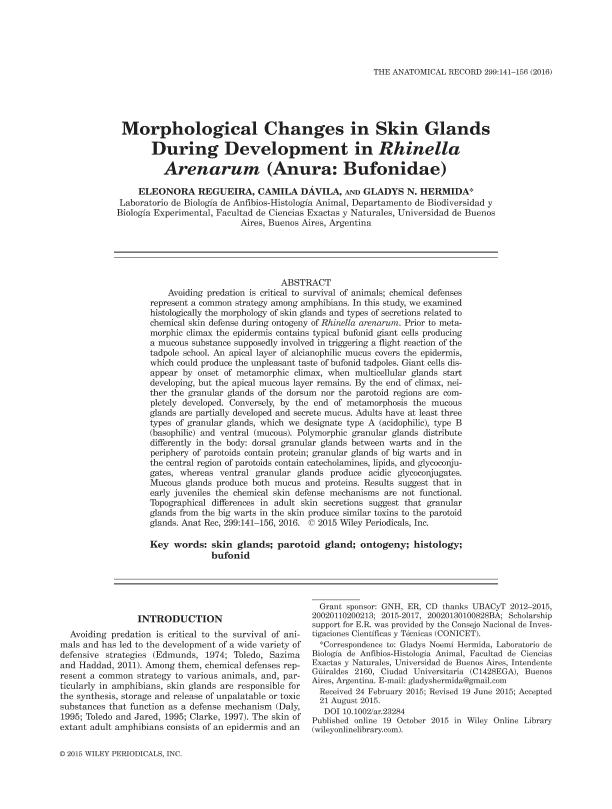Artículo
Morphological Changes in Skin Glands During Development in Rhinella Arenarum (Anura: Bufonidae)
Fecha de publicación:
01/2016
Editorial:
Wiley-liss, Div John Wiley & Sons Inc
Revista:
Anatomical Record-Advances in Integrative Anatomy and Evolutionary Biology
ISSN:
0003-276X
Idioma:
Inglés
Tipo de recurso:
Artículo publicado
Clasificación temática:
Resumen
Avoiding predation is critical to survival of animals; chemical defenses represent a common strategy among amphibians. In this study, we examined histologically the morphology of skin glands and types of secretions related to chemical skin defense during ontogeny of Rhinella arenarum. Prior to metamorphic climax the epidermis contains typical bufonid giant cells producing a mucous substance supposedly involved in triggering a flight reaction of the tadpole school. An apical layer of alcianophilic mucus covers the epidermis, which could produce the unpleasant taste of bufonid tadpoles. Giant cells disappear by onset of metamorphic climax, when multicellular glands start developing, but the apical mucous layer remains. By the end of climax, neither the granular glands of the dorsum nor the parotoid regions are completely developed. Conversely, by the end of metamorphosis the mucous glands are partially developed and secrete mucus. Adults have at least three types of granular glands, which we designate type A (acidophilic), type B (basophilic) and ventral (mucous). Polymorphic granular glands distribute differently in the body: dorsal granular glands between warts and in the periphery of parotoids contain protein; granular glands of big warts and in the central region of parotoids contain catecholamines, lipids, and glycoconjugates, whereas ventral granular glands produce acidic glycoconjugates. Mucous glands produce both mucus and proteins. Results suggest that in early juveniles the chemical skin defense mechanisms are not functional. Topographical differences in adult skin secretions suggest that granular glands from the big warts in the skin produce similar toxins to the parotoid glands.
Palabras clave:
Bufonid
,
Histology
,
Ontogeny
,
Parotoid Gland
,
Skin Glands
Archivos asociados
Licencia
Identificadores
Colecciones
Articulos(OCA CIUDAD UNIVERSITARIA)
Articulos de OFICINA DE COORDINACION ADMINISTRATIVA CIUDAD UNIVERSITARIA
Articulos de OFICINA DE COORDINACION ADMINISTRATIVA CIUDAD UNIVERSITARIA
Citación
Regueira, Eleonora; Dávila, Camila; Hermida, Gladys Noemí; Morphological Changes in Skin Glands During Development in Rhinella Arenarum (Anura: Bufonidae); Wiley-liss, Div John Wiley & Sons Inc; Anatomical Record-Advances in Integrative Anatomy and Evolutionary Biology; 299; 1; 1-2016; 141-156
Compartir
Altmétricas




